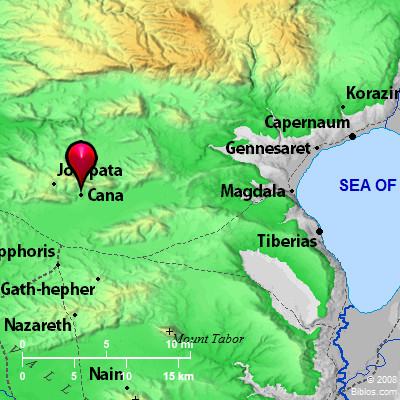Atlas  Kanah 2 (Cana) and surrounding area Maps Created using Biblemapper 3.0 Additional data from OpenBible.info Occurrences Joshua 19:28 and Ebron, Rehob, Hammon, and Kanah, even to great Sidon.Encyclopedia CANA, OF GALILEEka'-na, (Kana tes Galilaias): This was the scene of Christ's earliest miracle, when, at the marriage feast, He turned water into wine (John 2:1). It was the home of Nathaniel (John 21:2). From Cana, after the marriage, Jesus "went down" to Capernaum (John 2:12), and returned at the request of the centurion (John 4:46, 51). These are the only notices of Cana in Scripture, and from them we learn merely that it was in Galilee, and in the uplands West of the lake. Other villages of the same name are mentioned by Josephus, but probably this one is intended by the Cana where for a time he dwelt (Vita, 16) which he locates in the plain of Asochis (ibid., 41). The Greek kana probably transliterates an old Hebrew qanah, "place of reeds." This ancient name survives in Khirbet Qana, a ruined site with rockhewn tombs, cisterns and a pool, on the northern edge of Sahl el-Battauf, the plain of Asochis. Near by are marshy stretches where reeds still abound: the name therefore is entirely appropriate. The name Qana el-Jelil, the exact Arabic equivalent of Kana tes Galilaias, is also heard among the natives. This, however, may have arisen from the suggested identification with Cana of the Gospel. The position agrees well enough with the Gospel data. |



